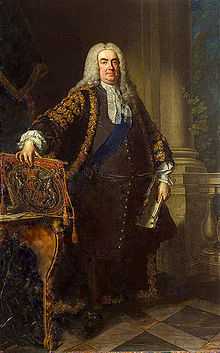George Byng, 1st Viscount Torrington
| George Byng, 1st Viscount Torrington | |
|---|---|
 Admiral of the Fleet George Byng by Jeremiah Davison in 1733 | |
| Born |
1668 Wrotham, Kent |
| Died |
17 January 1733 Southill, Bedfordshire |
| Allegiance |
|
| Service/branch |
|
| Rank | Admiral |
| Battles/wars | |
| Awards |
Viscount Torrington Order of the Bath |
| Relations |
Admiral John Byng Brig. Gen. John Byng |
Admiral of the Fleet George Byng, 1st Viscount Torrington, KB PC (27 January 1663[1] – 17 January 1733) was a British naval officer and statesman of the late 17th and early 18th centuries. His career included service as First Lord of the Admiralty during the reign of King George II.
Naval career
Byng was born at Wrotham, Kent, England.[1] In 1678, he entered the Royal Navy as a King's Letter Boy.[1] He left the navy for a brief time to join a military garrison stationed at Tangier, but rejoined the navy in 1683 as a lieutenant,[1] and shipped for the East Indies. In 1688 he was instrumental in causing the Royal Navy to switch allegiance to William III, Prince of Orange. This naval force took part in the Glorious Revolution of 1688, and William was installed as King of England, thus ensuring Byng's rapid rise in rank and fortune.[1]
In 1702, Byng was given command of the Nassau, and took part in the capture and burning of the French Fleet at Vigo.[1] The next year he was promoted to Rear-Admiral. In 1704 he was in the Mediterranean under the command of Sir Cloudesley Shovell, and led the bombardment squadron during Admiral Rooke's capture of Gibraltar.[1] Byng took part in the Battle of Málaga,[1] for which he received a knighthood.
In 1707, Sir George Byng served again under Shovell and took part in the unsuccessful Battle of Toulon. Sailing aboard his flagship HMS Royal Anne, he was present during the great naval disaster off the Isles of Scilly when Shovell and four of his ships were lost, claiming the lives of nearly 2,000[2] sailors.
In 1708 Byng was promoted to full admiral, and took part in the struggle against the Jacobite uprising in Scotland. In 1718 he was made Admiral of the Fleet and commanded the fleet which routed the Spanish Fleet at the Battle of Cape Passaro, thwarting the attempt of the Spanish to take Sicily.[1]
Byng was rewarded handsomely for this victory by George I and given full power to negotiate with the various princes and states of Italy, on behalf of the English crown. In 1719 he assisted the Germans in taking Messina, and destroyed the remaining Spanish ships which forced the Spanish king to accept the terms of the Quadruple Alliance. On his return to England in 1721 he was made rear-admiral of Great Britain, a member of the privy council, Baron Byng of Southill in the county of Bedford, and 1st Viscount Torrington in Devon.[1]
In 1725 Byng was made a Knight Companion of the Order of the Bath and in 1727, on the accession of George II, he was made First Lord of the Admiralty.[1]
Byng's administration of the Admiralty was distinguished by the establishment of the Royal Naval College at Portsmouth. He died in 1733 and is buried at Southill, Bedfordshire.[1]
Family
%2C_1st_Viscount_Torrington.jpg)
Byng had 15 children, and two of his 11 sons — Pattee (1699–1747) and George (1701–1750) — became respectively the second and third Viscounts Torrington. His fourth son Hon. Robert Byng (1703–1740), Governor of Barbados (1739-1740), was the grandfather of the soldier John Byng, 1st Earl of Strafford. His fifth son, Admiral Hon. John Byng (1704-1757), was controversially court-martialled and shot at the outbreak of the Seven Years' War in Europe.
The first Viscount Torrington's descendants retain the title to the present day.
Torrington Road in Portsmouth is named after him.
References
- ↑ 1.0 1.1 1.2 1.3 1.4 1.5 1.6 1.7 1.8 1.9 1.10 1.11 John B. Hattendorf, ‘Byng, George, first Viscount Torrington (1663–1733)’, Oxford Dictionary of National Biography, Oxford University Press, 2004; online edn, Oct 2009.
- ↑ Sobel, Dava, Longitude: The True Story of a Lone Genius Who Solved the Greatest Scientific Problem of His Time, Fourth Estate Ltd., London 1998, p. 6, ISBN 1-85702-571-7
External links
| Wikimedia Commons has media related to George Byng, 1st Viscount Torrington. |
| Parliament of England | ||
|---|---|---|
| Preceded by Charles Trelawny John Woolcombe |
Member of Parliament for Plymouth 1705–1707 With: Charles Trelawny |
Succeeded by Parliament of Great Britain |
| Parliament of Great Britain | ||
| Preceded by Parliament of England |
Member of Parliament for Plymouth 1707–1721 With: Charles Trelawny to 1713 Sir John Rogers 1713–1721 |
Succeeded by Sir John Rogers Pattee Byng |
| Military offices | ||
| Preceded by Sir Stafford Fairborne |
Admiral of the Fleet 1718–1734 |
Succeeded by Sir John Norris |
| Political offices | ||
| Preceded by The Earl of Berkeley |
First Lord of the Admiralty 1727–1733 |
Succeeded by Sir Charles Wager |
| Honorary titles | ||
| Preceded by Lord Aylmer |
Rear-Admiral of Great Britain 1720–1733 |
Succeeded by Sir John Jennings |
| Peerage of Great Britain | ||
| Preceded by New Creation |
Viscount Torrington 1721–1733 |
Succeeded by Pattee Byng |
| ||||||||||||||||||||||||||||||||||||||||||||

.jpg)